
34 minute read
An enduring educational legacy
AS IN ANY AREA OF HUMAN ENDEAVOUR, EDUCATIONAL IDEAS HAVE BACK-STORIES THAT HELP US UNDERSTAND THEIR BEGINNINGS, ADVOCATES AND MANIFESTATION IN DIFFERENT CONTEXTS, EXPLAINS DR DON CARTER, SENIOR LECTURER IN EDUCATION AT THE UNIVERSITY OF TECHNOLOGY SYDNEY.
Dr Don Carter is senior lecturer in Education at the University of Technology Sydney. He has a PhD, Master of Education (Honours), Master of Education (Curriculum), Bachelor of Arts and a Diploma of Education. Dr Carter is a former Inspector, English at the NSW curriculum authority and led a range of projects including the English K-10 Syllabus. His research interests include the effects of standardised testing, literacy pedagogies and curriculum theory and history. Dr Carter has published extensively on a range of issues including curriculum reform, English education and standardised testing. Previously in Education Matters, I drew attention to significant figures in our educational past. In keeping with this historical focus, this article illuminates key ideas of the German philosopher, psychologist and educationalist Johann Friedrich Herbart (1776-1841) whose ideas and their ensuing development by his acolytes (often called ‘Herbartians’) influenced major figures and practices in education for decades afterwards.
One key idea of Herbart’s was concentration. Based on the association of ideas – their relatedness - concentration involves placing one topic (or a group of topics) at the centre with other subordinate topics connected to it. This idea was extended by a follower of Herbart’s, Tuiskon Ziller, who advocated the deliberate establishment of a relationship between topics which he labelled correlation. This idea saw that the study of a topic such as American history would connect with the study of American literature, and so on.
In fact, a version of correlation, called the complex method, was implemented in the USSR in the 1920s. This involved abolishing individual subjects such as reading, science and history in favour of integrating the disciplines into a thematic unit that might, for example, focus on daily life. More recently, an approach to teaching the NSW primary curriculum known as Connected Outcome Groupings (COGs) was undertaken between 2006 and 2013 to promote the teaching of a “balanced curriculum across key learning areas” aimed at “making connections between ideas” to enhance student learning. Furthermore, a version of this idea was again apparent in the NSW senior English syllabus from 1999 to 2018 with the Area of Study requiring the investigation of a number of prescribed texts through the lens of a specified concept such as ‘belonging’ and ‘journeys’. Each is reminiscent of a Herbartian approach to the correlation of topics and subjects.
The idea of a ‘pivotal topic’ was also extended to curriculum organisation where a specific subject was anointed to develop a student’s sense of morality and for Herbart, the study of literature satisfied this criterion. Again, this idea was discernible in the early 20th century in NSW with the subject of English becoming the hub of both the primary and secondary curriculums where the development of students as active, responsible citizens was to be achieved through the study of literature.
In addition, the scholar Peter Meadmore argues that the 1905 NSW primary syllabus was based on Herbartian educational principles and points out that this syllabus was subsequently appropriated by Queensland educational authorities a year later without amendment, thus introducing a Herbartian approach in that state.
Another key idea of Herbart’s adopted by his followers was a ‘many-sided’ interest which, as Herbart wrote, was the “readiness to form new ideas”. This was based on the notion that by capturing a student’s attention, motivation can be cultivated and with that, interest in an object, idea or activity, resulting in the retention of specific knowledge. This then leads to a deeper opportunity for the student to develop an interest into the variability and multi-faceted nature of issues and topics – thus demonstrating a many-sided interest.
This emphasis on interest was central in the development of the Dalton Plan pioneered by Helen Pankhurst in the early 20th century, an approach still used today in Dalton schools in the US, the Netherlands, Japan and one in Sydney, Australia. In the 1920s and early 1930s,
Herbart’s ideas also enjoyed a rebirth in the form of the Morrison Plan developed by the University of Chicago which focused on the delivery of classroom units of work each a week in duration.
Another of Herbart’s ideas was that of ‘apperception’, involving the integration of new ideas into previously formed constellations of ideas as part of an incremental building process. This means that when the individual assimilates new information based on preceding perceptions, it incites or imitates similar ideas so that a mass of ideas assimilate and associate with other similar new ideas and in doing so, relegate opposite ideas to the outer consciousness. Learning is therefore seen as organising ideas into larger systems of understanding, where, as Herbart asserts, “The better the apperception masses… the more closely and easily and effectively a person would think.” And as curriculum historian Stanley Ivie points out, Herbart’s ideas influenced major figures in the 20th century with the American psychologist Jerome Bruner replacing the term ‘apperception’ with
‘structure’ while retaining the same meaning.
Herbart also emphasised the importance of systematic instruction through an ordered and sequential approach to teaching and learning based on clearness, association, system and method. These were further developed by devotees such as Wilhelm Rein, Tuiskon Ziller, Karl Volkmar Stoy and Charles DeGarmo. The four conditions were expanded by DeGarmo to ensure that teaching provided clearness in the presentation of specific facts; association of these facts with one another, and with other related facts previously acquired; the systematic ordering of facts; and the methodical application in exercises of the facts. Such an approach is evident in versions variously labelled ‘explicit instruction’, ‘direct instruction’ and notably in Madeline Hunter’s prominent ‘7 Step Lesson Plan’ which was widely adopted across the US in the 20th century.
The list of those influenced by Herbart does not stop there – E.D. Hirsh, like Herbart, also promoted guided instruction from the teacher where the pace and content of the lesson is directed by the teacher; and according to Ivie, B.F. Skinner’s operant conditioning and David Ausubel’s scaffolding and anchorage also can be attributed in part to Herbart and his theories. Thus, Herbart’s rich legacy extends across many decades and countries and is worth investigating to shed light on our current practices. EM
educationmattersmag.com.au is a leading source of breaking industry information. The website is updated daily with news, policies, governance, curriculum and editorial from leading authorities, industry experts and ministerial decision makers.
All advertisers in Education Matters Magazine are given the opportunity to have a premium profile page in the Premium School Suppliers Directory. The Premium School Suppliers Directory has a user-friendly interface making it easy for educational professionals to search for products and services they may require for their school.
This is your one stop shop for anything your school or learning facility may require. You can browse any category or use our search function to find what you require.
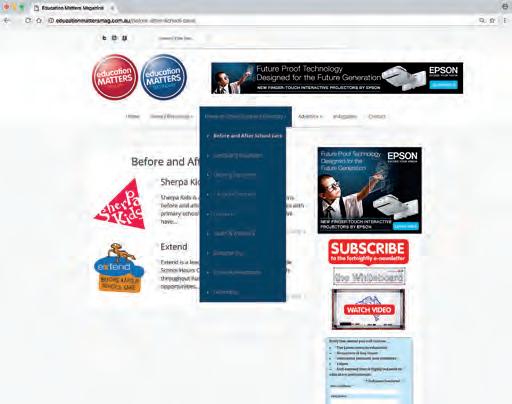
More than just grammar
THE LIFELONG WORK OF A TEACHER FASCINATED BY LANGUAGE, LEARNING, LINGUISTICS, NEUROSCIENCE AND ASSESSMENT, GRAMATICA AIMS TO REVERSE THE AGE-OLD DISLIKE OF GRAMMAR AND INSTEAD REMAKES IT INTO SOMETHING ALTOGETHER INNOVATIVE, SIMPLE, RELEVANT AND FUN.
Imagine a school where both teachers and students are empowered, decisive and knowledgeable writers, where everyone speaks the same grammar and writing language, and everyone knows how to assess grammar and writing, their own and others’.

HOW DOES IT WORK? Gramatica combines writing and grammar into a single, holistic area. It trains students to focus their attention firstly onto the writing task. What do they need or want to write about? Do they want to write an action story or a persuasive text, a fantasy epic or a list of instructions? This first part is easy.
Having established this, they then consider what grammar tools they need, and Gramatica provides this grammatical knowledge with clear, visual structure and simple language that everyone understands, from the youngest pre-primary student to senior students.
Writing has always had a reason, but grammar has tended to be taught in isolation and viewed as rather unnecessary and boring. In linking the two, Gramatica gives grammar a reason. Now it becomes the road to achievement and success, both at school and for life.
WHAT DOES IT INCLUDE? Gramatica includes the entire learning journey from teacher training to student assessment. It sets the end learning goal and shows students how to reach it. Along the way, it shows students how to formatively assess their own work using reliable, visual learning cards, and gives both teachers and students the metalanguage they need to do so.
ON WHAT RESEARCH AND EVIDENCE IS IT BASED? A great deal: the combined knowledge of many years of lecturing undergraduate and postgraduate B.Ed students at ECU, teaching ESL to adults, writing a novel and getting it published, and reading extensively about language, alphabets and linguistics. Gramatica is based on the neuroscience of Zadina, Zull and others, the pedagogy and assessment of Hattie, Wiliam, Timperley, Allen and Readman and others, and the far-reaching implications of Bloom’s Taxonomy.
WHO BENEFITS? Everyone. Students become empowered, confident, decisive writers, teachers gain the knowledge of grammar they have often lacked, and the whole school gains a common, simple language for both teaching and assessing grammar and writing. EM
Buyer’s Guide Gramatica Web: www.gramatica.com.au
Greg Byrne has loved the English language since he first experienced it as a child, a passion that continues unabated today. He teaches English at a Perth ESL college and lectures at Edith Cowan University (ECU) in the Bachelor of Education degree. He has also spoken about Gramatica at conferences around the world – New Orleans, Cambridge, the Philippines, Melbourne, Brisbane and Perth. In his spare time, he thinks about grammar, pedagogy and assessment, writes novels, travels and adores his family.
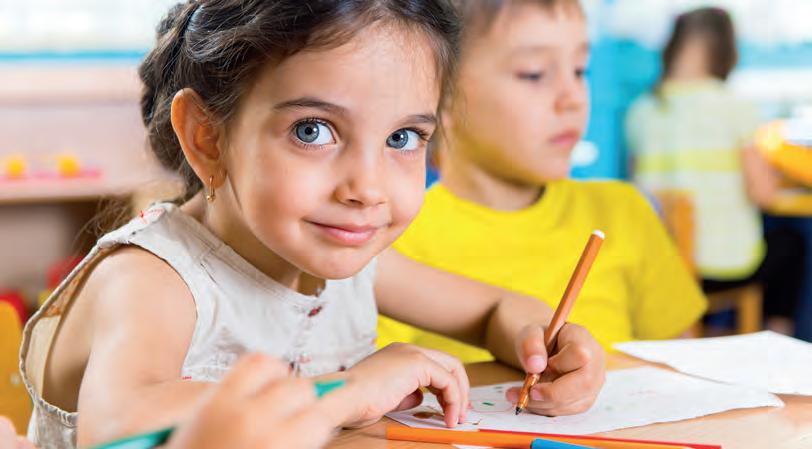
Intervention demonstrates dramatic PAT Maths growth
NEW PEER-REVIEWED RESEARCH SHOWS STUDENT GAINS OF 27-29 MONTHS BEYOND THE 24-MONTH EDUCATION DEPARTMENT EXPECTATIONS. THIS WAS MEASURED BY PERFORMANCE ON PAT MATHS FOR THE LOWEST 20 PER CENT OF STUDENTS ACROSS SIX PRIMARY SCHOOLS IN SOUTH AUSTRALIA.

Throughout the two-year project, published by the Mathematics Education Research Group of Australasia. all teachers across all six schools were required to implement one lesson each week that paired a challenging mathematics task with a unique sequence of linked questions designed to target underlying misconceptions. Mathematics Consultant, Tierney Kennedy, provided in-person professional learning for leaders from each school, who were in turn responsible for training their own staff. Teachers were provided with lesson plans from the series Interventions in Mathematics and webinars with the consultant.
“It was a game changer for many teachers. Teachers talked about how much they learned and the impact it had on their classrooms. As an Education Director, I witnessed changes in classroom practice as I visited schools,” says Gerri Walker, Executive Director for Torrens Valley Partnership (2015-2017).
While the Conceptual Change Approaches are new in Australian mathematics research, similar methods have been well-researched in science with an effect size of 0.99 putting them in the top ten in the Hattie Ranking (2017). Ms Kennedy’s research showed an effect size of 0.7 over and above the annual 12-month expectations of the department for each year of the
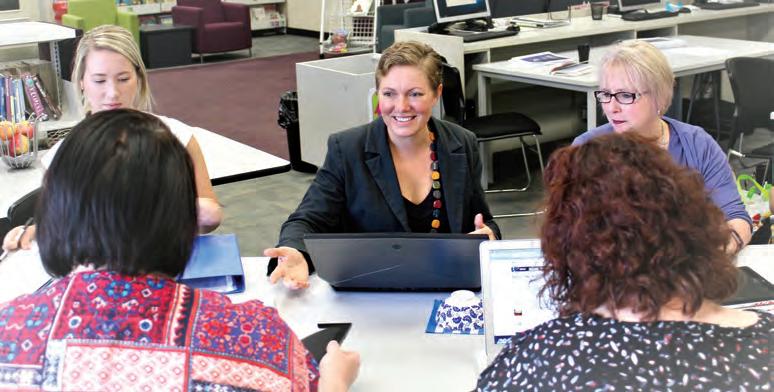
project. In fact, every group of students caught up to the education department expectations for Progressive Achievement Tests in Mathematics within 12 months, with no additional time or withdrawal provided.
So how does it work? Ms Kennedy says it takes a simple mind-shift for teachers to approach problemsolving in maths as experimenting rather than as applying. Students begin by making conjectures as to what the answer might be, then work to prove or disprove their ideas. The teacher’s job is to, “Ask questions to draw attention to any disparities (evidence that disprove an idea), enabling a student to disprove their own idea and then try out a new one.”
Teacher questioning focuses on helping students to evaluate their own ideas rather than on pointing them towards the correct answer, which according to Ms Kennedy, encourages students to change their own minds.
It is this unique approach to questioning that principals have attributed their high growth to, with 87 per cent of the schools exceeding Australian NAPLAN cohort gain throughout the project. And the results are not limited to just low achieving students – according to Ms Kennedy her next paper explores the causes of the exceptionally high growth made by the highest 20 per cent of students in the same project (0.62).
The original research paper, as well as free resources to support teachers and leaders can be found at www.backtofrontmaths.com.au.
The Fixing Misconceptions book bundle contains all the programs in the Highly Commended Intervention in Mathematics series. It can be found by visiting the website below. For a 10 per cent discount, please enter the code isfmset-save10. EM
Take the next step in your primary teaching career
PRIMARY SCHOOL TEACHERS PLAY A PIVOTAL ROLE IN HELPING TO SHAPE THE FUTURE OF OUR YOUNG PEOPLE, AND THERE IS AN ONGOING DEMAND ACROSS THE COUNTRY FOR QUALIFIED TEACHERS TO HONE THEIR LEADERSHIP QUALITIES AND STEP INTO HIGHER-LEVEL ROLES.
With job and career growth opportunities for primary school teachers currently booming, now is a great time to be considering the next step in your pathway towards a more senior position. While upskilling via a postgraduate qualification is now considered an essential for those wanting to work their way up within education, the challenge faced by many is how to find the time. As demand for highly skilled primary school teachers continues to soar, leaders in online higher education, Open Universities Australia (OUA), now offer more than 25 online postgraduate education degrees from leading Australian universities, enabling students to drive their careers forward without having to sacrifice their income, family and other life commitments.

SKILLS TO SET YOU APART While the hierarchical approach to school leadership may have been acceptable many years ago, this is certainly no longer the case. Emotional intelligence, a growth mindset and the ability to work collaboratively with other members of staff are the sorts of qualities that make for a far more successful educational leader, according to Petrah Harslett, director of Australia’s leading education job site, Teachers on Net.
“Being able to apply leadership skills to different areas comes down to emotional intelligence and the ability to get along with others and build a team around you. Empathy, collaboration and communication are key skills; and this is the case for both primary and secondary schools. Understanding mental health has also become very important – it’s about understanding your own mental health and understanding the mental health issues that can happen in a school, both with staff

and students,” says Petrah. Through speaking with various principal associations and other experts on educational leadership, Petrah says that interpersonal skills are also crucial in setting someone apart when it comes to selecting candidates for higher level positions. “If you’re a maths teacher for example, it’s less about how brilliant you are at maths; and more about how well you get along with other staff members and how well you are able to work with them to achieve the desired outcomes.” Petrah strongly encourages aspiring school leaders to embark on a Master of Education to hone in on the skills required to achieve their goals, and to gain a better understanding of themselves and what they wish to achieve. “For those wanting to get into a school leadership role, my advice is to work on yourself and consider something like a Master of Education for the self-development and vast growth opportunities that comes out of it.”
MAKING A REAL DIFFERENCE REQUIRES LEADERSHIP To be considered for roles such as head of faculty, curriculum coordinator or principal, a postgraduate degree such as a Master of Education will enrich your critical thinking, inform new perspectives on professional practice and also show employers that you’ve developed the in-depth knowledge and skills needed to investigate and solve complex educational issues. “A Master of Education provides educators with the opportunity to get involved in lots of projects at their school, forces them into opportunities where they have to work on their leadership skills, and offers them visibility, where they get to showcase their leadership skills,” says Petrah. Choosing to study a Master of Education with leading Australian universities online through OUA allows busy students to upskill at their own pace and on their own schedule. The large breadth of choice means that you can choose the right degree for you, or even mix and match subjects from multiple universities to align with your own personal goals. At the end of the degree, students will graduate with exactly the same qualification as if they had studied on campus.
At the end of completing Curtin University’s Bachelor of Education (Primary Education) through OUA, aspiring school principal, Ally Kettle, moved onto Curtin’s Master of Education, also through OUA. Balancing her study with a graduate teacher position, it’s been a busy, yet fulfilling, few years for Ms Kettle who has always dreamed of becoming a teacher and says that she owes her success to the flexible nature of online study. “I teach science to primary school children and so for me, being a STEM teacher and being able to study master’s level units specifically in the area that I’m teaching is extremely helpful and has really enhanced the way in which I approach my work in the classroom,” says Ms Kettle. “I’m able to study at any time, anywhere and when it suits me which is amazing when you’re working as a teacher and have a busy lifestyle.”
NEW KNOWLEDGE DELIVERS NEW ENERGY Gain the expertise you need to become a school leader. There’s no need to give up your day job to take on further study – through OUA there are more than 25 Master of Education degrees from leading Australian universities to choose from. Graduates receive exactly the same qualification as on-campus students, but can obtain their master’s from the comfort of their own homes. Explore your options online or call a friendly student advisor on the phone number below. EM
Buyer’s Guide Open Universities Australia Ph: 13 OPEN Web: open.edu.au
Maths tasks that challenge the whole class
A TEAM FROM MONASH EDUCATION HAS BEEN WORKING WITH TEACHERS TO TEST THE EFFECTIVENESS OF A SERIES OF MATHEMATICS LESSONS USING CHALLENGING TASKS FOR EARLY PRIMARY CLASSES.
The tasks are connected, cumulated and challenging, and form a single sequence of learning. Students are required to work out the answers themselves, with teachers providing support only at key strategic times.
LAUNCH, EXPLORE AND SUMMARISE These lessons have three phases. When the task is launched, students are given the task without instructions on how to solve it. They then explore strategies and ways to solve the problem. The teacher then selects different students during the summarise phase to share their mathematical thinking and strategies with the rest of the class.
Throughout the lesson the teacher can use enabling or extending prompts to support students at all levels.
HOW IT WORKS IN PRACTICE On TeachSpace – Monash Education’s new resource for teachers – Dr Sharyn Livy and classroom teacher Mark Pietrick show how a 12 cubes task was used with a Year 1-2 class.
Proficiencies and curriculum outcomes are outlined, and a two-part lesson plan provided, along with a video that demonstrates the lesson in practice.
The lesson was designed to assist students to develop the understanding that the same number of cubes can be used to make different prisms. The big idea was that the same volume can look different.
The question was: “A rectangular prism is made from 12 cubes. What might the prism look like? Give some different answers.”
Students used their 12 blocks to make prisms and took a photo of the various prisms they created on an iPad. They drew and labelled their answers on paper.
There was more than one solution, and all students constructed different prisms with the same volume and number of cubes.
Students then shared, explained and justified their mathematical thinking.

A student from St Anthony’s works on the 12 cubes task.

TEACHER FEEDBACK Mr Pietrick has trialled these kinds of tasks in his classroom for two years, and encourages teachers to give it a go. “If you are not used to this technique, it can feel like a bit of a disaster, especially if you haven’t done it before,” he said.
“But it does really work. The kids love it. They enjoy the challenge of the tasks and making those connections. You really do see the benefits of this type of learning and where it can take the kids with their maths.”
This project will continue thanks to a recent three-year Australian Research Council linkage grant. Monash will be partnering with the Catholic Education Dioceses of Parramatta and Catholic Education Melbourne to further investigate similar lesson ideas and develop mathematical resources for teachers and their students in the early years. EM
A seamless partnership
SINCE INTRODUCING SHERPA KIDS’ OUT OF SCHOOL HOURS CARE PROGRAM TO ITS STUDENTS FIVE YEARS AGO, ST PAUL’S CAMDEN HASN’T LOOKED BACK. THE STRUCTURED YET FLEXIBLE APPROACH HAS BECOME A WELCOME ADDITION TO THE SCHOOL.
With a high number of its students requiring before and after school care, St Paul’s identified the need for a more suitable solution.
Without a service of this kind previously offered at the school, parents were having to rely on external providers. Based in Sydney’s south-west, in a busy part of Camden, having busloads of students being brought to and from the school was becoming a logistical nightmare.
That’s when Michael Rasmussen, who is the current General Manager of Sherpa Kids and was teaching at St Paul’s at the time, suggested adding Sherpa Kids’ programs into the school’s offering.
“There was a high number of students requiring before and after school care. Outsourcing with those sorts of numbers, it was obvious this needed to change. The school saw a real need to enlist a third party. Based on what Sherpa Kids could provide, St Paul’s decided to develop that opportunity under Mr Rasmussen’s direction,” says St Paul’s Principal, Michael Reardon.
Making use of St Paul’s existing facilities, Sherpa Kids has been run out of the school hall since January 2014.
There are 615 students attending the school, with approximately 250 students using the before or after school care services provided by Sherpa Kids each week. These services are also utilised by a public school located just across the road.
Mr Reardon says the programs have provided a positive solution to the school’s outside of school hours care requirements, giving him one less thing to worry about.
“The fact that all of the administration is taken care of is great. I love the fact that I don’t need to worry. The programs have an element of flexibility but at the same time, staff are very consistent. And as Mr Rasmussen comes from an educational background, I know I can trust in the way things are run,” Mr Reardon says.
He adds that the feedback from students has been positive too. “They actually like attending the program. It involves a lot of physical activity which is important. These are the sorts of activities we can’t provide during school times because time doesn’t allow for it. It’s great that it encourages kids to be moving around, especially when kids these days can spend a lot of time sedentary.”
According to Mr Reardon, Sherpa Kids has become a highly valued part of the school’s offering. “We see our relationship with Sherpa as very important, and that is reciprocated. I don’t take it for granted, and neither do they. The program runs so smoothly. It’s almost like Sherpa Kids has become part of the school because it’s just so seamless.” EM
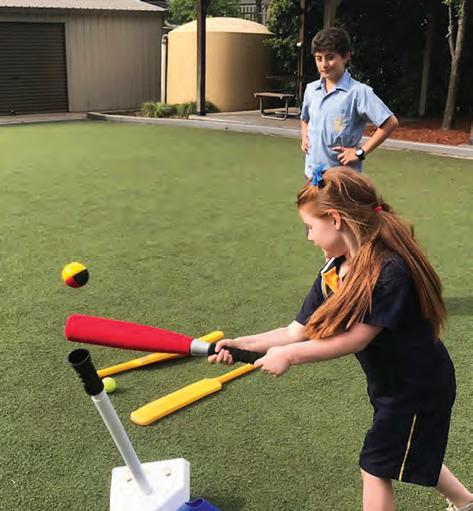
Sherpa Kids has become a valuable part of St Paul’s Camden’s offering.
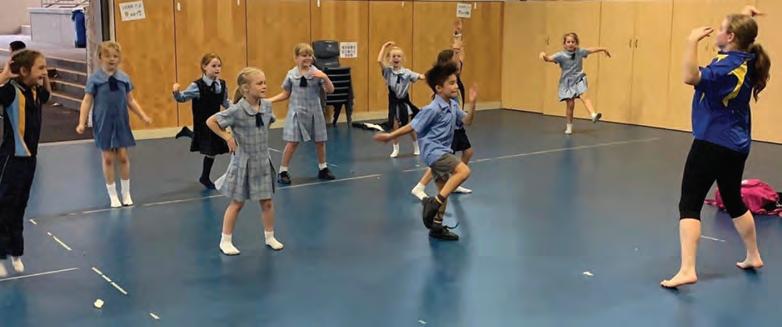
Finding the right balance
DEDICATED TO CREATING PLAYGROUNDS WITH UNIVERSAL DESIGNS THAT SUPPORT EQUALITY IN PLAY, KOMPAN AUSTRALIA HAS RELEASED A NEW PUBLICATION THAT HIGHLIGHTS THE IMPORTANCE OF INCLUSION AND PROVIDES GUIDELINES ON CREATING SPACES THAT CATER TO ALL.
KOMPAN was founded on the principle that “children unfold their imagination through play and thereby learn and develop their social and cognitive skills.” Its play and activity solutions are designed to encourage fun while promoting the development of physical, social and learning skills. Children and adults alike are encouraged to learn and play together, regardless of their abilities.
Utilising over 40 years of experience in designing play solutions, including children with disabilities; and combining this with the increased focus it has placed on observational studies and insights over the past five years, KOMPAN shares its findings in its new Play For All: Universal Design for Inclusive Playgrounds publication. It brings together observations, insights and new research on accessible, inclusive and universal play equipment and playgrounds, and provides a number of recommendations for planners and designers to use as a guide.
The United Nations Declaration on the Rights of Persons with Disabilities (2006) recommends a universal design methodology as the most efficient way of ensuring equality of access to and use of public services and facilities. This

The Birds Nest Swing supports varied body positions including seated, lying and standing.
means applying an inclusive approach to all public planning – and thisincludes the school playground.
As playground planners and designers, equal possibilities for outdoor play is crucial. But, many can struggle with the guidelines and directions for planning inclusion when it comes to playground design. This goes far beyond accessibility. Motivating and including all users by offering relevant, useable solutions is where the big challenge lies. Very specialised designs can sometimes have the effect of stigmatising rather than including. Highly accessible spaces can lack thrill and excitement. Though accessible, they can be perceived as boring. It is all about finding the right balance.
Studies show that children with disabilities who play with typically developing children grow and develop an understanding of their own abilities and strengths, and develop a more positive image of themselves. For typically developing children, direct contact with peers with disabilities has a positive impact on their tolerance and empathy.
Play areas need to be both accessible and relevant. An accessible, inclusive and universal playground should consider the widest number and range of potential users possible, including children with and without disabilities, as well as parents and carers with or without disabilities.
To ensure accessibility, spaces should provide sufficient access for both foot traffic and wheelchairs, along with firm safety surfacing and firm pathways to play activities. To cater for a wide range of users, spaces should also feature multiple access points.
As highlighted in the Play for All publication, there are six universal playground design points: • Accessible, inclusive routing and infrastructure: This includes accessible surfacing to and around activities, clear design signals, and alternative entrances and exits to the play area and equipment. • Access to relevant ground-level activities: Surfacing around play activities needs to be accessible, there should be varied access possibilities into and onto play activities, and play activities should support varied body positions.
The Mungret autism-friendly playground in Limerick, Ireland includes quiet areas for solitary reflective play.
• Access to relevant elevated-level activities: Consider the access and egress motivation and possibility of elevated-level activities, and consider the thrill levels and the social benefits of elevated levels. • Support thrilling and challenging play: Offer thrilling activities such as spinning, swinging, swaying, bouncing, gliding or sliding; along with graded play challenges – some that are easier and some that are harder; and offer variations of thrill including physical, social, cognitive and sensory. • Support social interaction: This refers to activities that can be done together with others. Two of each parallel play options are also great for trainingsocial skills. • Variation in play activities: Provide wild and quiet activities; provide physical, social and cognitivecreative activities; and offer spaces for breaks such as seating.
There are also six points to consider for universal play equipment design: • Ground-level usability. • Responsive or thrilling. • Play from all sides (i.e. 360 degree design). • Two-sided play activities on play panels. • Transparency in design. • Multifunctional whenever possible.
Spinners and carousels can be great examples

The Tipi Carousel supports easy entry and exit for children with physical impairments.
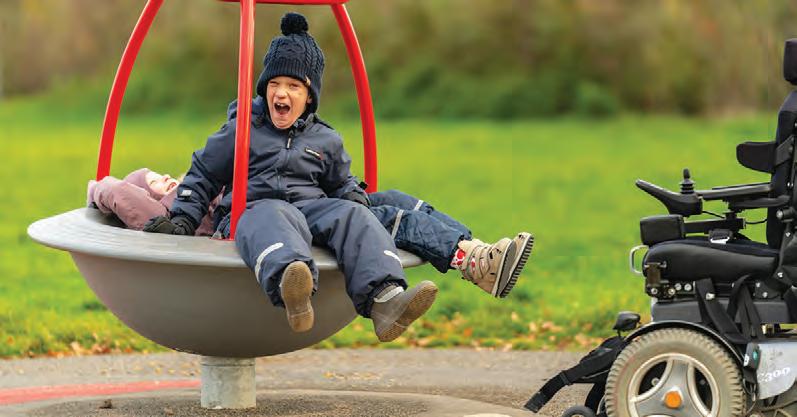
of inclusive, universal play equipment. Spinning and rotating trains the senses of balance and spatial awareness. These crucial motor skills help children to sit still on a chair, for example. The training of balance is particularly important for children with autism and vision impairments, as well as a range of physical disabilities. Springers and seesaws train the vestibular system, and the understanding of cause and effect. Bouncers and swayers add thrill or comfort depending on their intensity, helping to develop spatial awareness and train the sense of balance. Swinging also trains spatial awareness and the sense of balance. Sand and water play on the other hand creates sensory stimulation.
By creating a universal playground that caters to various skill levels and abilities, all users benefit. EM
Promoting exercise during break times
BEING PHYSICALLY ACTIVE IS IMPORTANT FOR A CHILD’S PHYSICAL, MENTAL AND SOCIAL DEVELOPMENT. PLAYGROUND DESIGNERS AND CONSULTANTS, PLAYROPE, DISCUSS THE LINKS BETWEEN EXERCISE AND ACADEMIC PERFORMANCE.
There have been various studies that have linked children being physically active with their intelligence quotient, concentration capacity and linguistic and mathematical skills. Aside from this, there are also the obvious benefits of physical activity like assisting to reduce the likelihood of obesity and reducing the instance of postural deformities.
While students spend much of their school day sedentary, break times offer the perfect opportunity to get the body moving. In a primary school setting, choosing the right play equipment can encourage students to undertake basic forms of exercise such as balancing, climbing, jumping, bouncing, rocking and swinging. This helps to strike an important balance with cognitive learning in the classroom and is also conducive to a child’s development. Suitable play equipment can also assist students with learning to assess risk and play equipment that encourages role play can assist with the development of a child’s social and communication skills.
To fully benefit the students using the playground, play equipment should encourage a versatile range of exercise, offer a high degree of challenge, accommodate as many children as possible and provide the necessary degree of safety.
This space features a Tetragode from PlayRope supplier Berliner, which provides plenty of room for many children to play on it at the same time.

A VERSATILE RANGE OF EXERCISE The act of balancing requires coordination and concentration. To solve an equilibrium task, skills like perception, planning, risk assessment, decision making and reacting alternately in quick succession are necessary. These skills can be promoted an attractive balancing and handrail offer in the school playground. Examples of play equipment that rely on the act of balancing include slacklines, nets, hand ladders and jungle or rubber bridges. Equipment that promotes the swinging of the arms has similar effects on development. This strengthens arm and shoulder muscles, and encourages balance and coordination.
By including play equipment that encourages the act of climbing, it helps to train a child’s sense of balance and body awareness. On a neurological level, climbing in a three-dimensional space stimulates interconnecting patterns in the brain, namely those that stimulate the imagination, which in turn are needed in three-dimensional computing.
Through jumping and bouncing, a certain degree of muscle power is required. Play equipment that encourages these types of movements also requires children to land safely, which promotes coordination and balance. When jumping down from a piece of play equipment, the child assesses the risk. By providing flexible or bouncy play equipment, children are given a particularly exciting challenge in this regard.
While designing a play space that encourages a wide range of movements is important for a child’s physical and mental development; there are a number of factors to consider too. From the school’s perspective, the playground should also offer ease of supervision, simple maintenance, a long service life and the ability to add to or extend the existing play space in the future. CREATING CHALLENGE An ideal play space provides a stimulating environment that challenges its users. Incorporating an appropriate level of challenge can benefit children as they learn to self-assess risk. This also adds an element of excitement as children learn how to navigate the equipment. By providing play equipment that is interesting and exciting, children are more likely to use the space during their break times, which encourages physical activity and exercise. SPACE FOR ALL During the school day, a large group – if not all – students have their breaks at the same time. Therefore play spaces should accommodate a high number of children at any given time, ensuring they have enough room to exercise and work their developing muscles. By ensuring play equipment can be used by a high density of students in unison, it ensures more students have the opportunity to exercise during their break times. Choosing play equipment that encourages basic forms of exercise such as balancing, climbing, jumping, bouncing, rocking and swinging helps to promote physical activity. The Roplay Ball, as seen on this playground at Casula Public School in Sydney, provides the opportunity to swing, rock and climb.

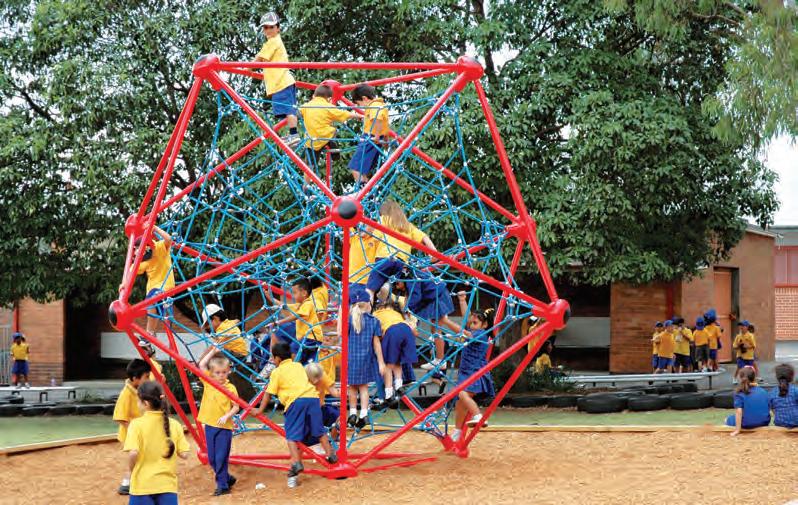
CREATING A SAFE ENVIRONMENT While a successful play space incorporates a calculable risk, it is vital that all play equipment offers the necessary level of safety. Each piece of equipment should be designed so that the chance of serious injury is avoided. A degree of risk assists children to understand danger and consequence. EM
Playground design – How to get it right?
WILLPLAY’S GENERAL MANAGER NATHAN LEE SHARES TIPS FOR CHOOSING THE RIGHT SCHOOL PLAYGROUND FOR A VARIETY OF LEARNING ENVIRONMENTS.
With the challenge of our changing lifestyles and the need to activate students into movement and non-digital play, the humble school playground has taken on new importance in the lives of students. Getting it right can make a amazing difference to student mobility and physical wellbeing. Getting it wrong risks losing an amazing opportunity to make a difference.
Playground design can be a fun process for all involved, however it can be a bit daunting for the uninitiated. WillPlay is an Australian manufacturer of play and fitness equipment. With extensive experience in designing play areas for schools, my team and I can help you through the complete design and construction process.
Know your user: The play and physical needs of preppies is different to students in upper primary. Determine the age range and physical needs of your intended users and choose the equipment that best suits. If the play area is to suit a wide range of ages, talk with your designer to ensure all physical levels are catered for. WillPlay also manufacture a range of

equipment to cater to the needs of students of varying abilities.
Define your outcomes: Is this to be a imaginative play area or do you want more physically challenging equipment? Do you want both? By combining systems from a variety of WillPlay’s ranges, you can design a play area that achieves both. Material selection: WillPlay lead the industry in the use of premium materials such as stainless steel, aluminium and recycled plastics and composites. Do you want the natural look of timber but not the maintenance hassles? Consider the TreeHouse range from WillPlay featuring their timber look aluminium posts.
What is the best softfall?: Whether to choose an organic product like sand or Takura Engineered Softfall or to use rubber or synthetic grass will often be determined by budget. The different materials all have their own benefits and disadvantages so talk with your designer to determine the best material for your area. Combining materials will often give a visually appealing result and offer different experiences in the area.
Do you want shade with that? As play time is usually in the hottest parts of the day, shade can be an important yet often ignored aspect in the design. Whether you choose a shade structure or work with the existing natural shade from trees and buildings, getting this right will encourage greater use of the area.
Spare parts and after-market support: Talk with your prospective equipment suppliers and ask about the availability of spare parts and the manufacturer’s warranty and support. As a local manufacturer of play equipment, WillPlay stock a wide range of spare parts and accessories and their rapid shipping time ensures you’re play area is up and running and downtime is kept to a minimum. EM
A tailored approach to adventure
PGL ADVENTURE CAMPS TAILORS ITS PROGRAMS TO BEST MEET THE DESIRED OUTCOMES OF EACH SCHOOL GROUP AND ITS TEACHERS, OFFERING A MEMORABLE EXPERIENCE THAT ENCOURAGES STUDENTS TO STEP OUT OF THEIR COMFORT ZONES.
Offering residential adventure camps for students at three sites – Camp Rumbug and Campaspe Downs in Victoria, and Kindilan in Queensland – PGL offers a range of outdoor adventure-based programs for primary and secondary schools, which can be adapted for small numbers through to whole year groups.
Jack Weston, PGL Camp Rumbug’s Centre Operations Manager, says that all PGL programs allow guests to take responsibility for their own experience.
“We will always exercise ‘Challenge By Choice’ for guests while facilitating those guests to step outside of their comfort zone and into their stretch zone. All guests will walk away after completing a program with increased self-esteem, a sense of pride and most importantly fun through the activities they participated in,” explains Jack.
Jack joined the business in 2014. As part of his role, he writes activity programs to cater to each individual group of students taking part in PGL’s camps. The camps offer close to 30 land and water activities which include abseiling, the flying fox, raft building, a challenge course, giant swing and initiative exercises.
“Before any program is written we will work closely with the

PGL offers a range of outdoor adventure-based programs for primary and secondary schools.
school or group travelling to find out any desired outcomes so that we can then build an activity program that allows guests to complete requested activities, but also build in certain activities that will allow facilitation of their learning outcomes more easily,” he says.
Jack says that the number one objective when writing a program is to understand what learning outcomes and activity requests the group completing that particular program has.
“Our instructors are incredibly skilled at incorporating learning outcomes into all activity sessions.”
According to Jack, PGL’s instructors also play a pivotal role in determining what students take out of the program they participate in. In a climbing activity for example, it can be all about personal achievement if the instructor tells the student to climb as high as they can go. But if instead the person climbing the wall is directed by a buddy on the ground, it encourages communication, peer support and teamwork.
“We listen to what teachers want for their students, and change every session toward what the teachers are hoping to achieve,” adds Jack.
“Initially I underestimated the impact that experiences in an outdoor environment could have for children – especially with the two-night program length. However this quickly changed after witnessing children who have struggled in a traditional education setting thrive in our programs.
Jack says that this has been echoed time again by school staff who comment regularly about the changes in behaviours they see in the outdoor environment for their students. “Outdoor education plays a key role in building on the outdoor experiences children learn at a young age through outdoor play.” EM
Buyer’s Guide PGL Adventure Camps Ph: 1300 859 895 Email: info@pgladventurecamps.com.au Web: www.pgladventurecamps.com.au








